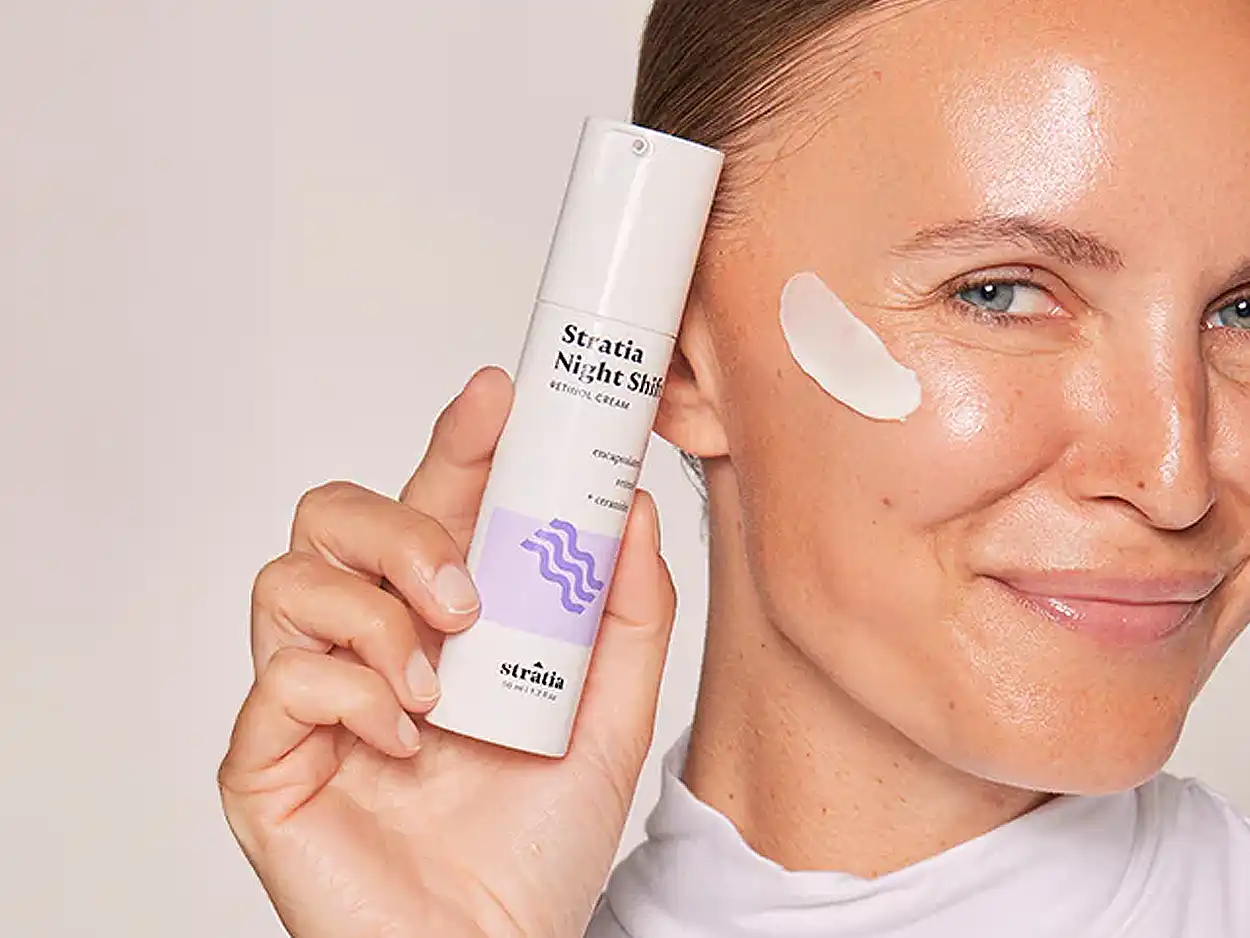Stratia may not yet have the household recognition of the global giants but among skincare enthusiasts its reputation for smart formulations and transparent science is rock solid. The brand has a knack for giving skin nerds what they ask for without the inflated price tags or fluffy marketing speak.
Enter Night Shift, a name that sounds like it should come with a steaming mug of coffee and a fluorescent desk lamp. Instead it promises to do the graveyard shift for your complexion while you sleep, relying on a modest 0.15% retinol wrapped in a lipid sphere plus a supporting cast of ceramides, panthenol and centella asiatica to deliver calmer, smoother and bouncier skin by morning.
I dedicated a full two weeks to Night Shift, applying it every evening to see if this overnight treatment lives up to its confident claims and is worth staking part of your skincare budget on.
Disclaimer: this is not a paid or sponsored review. The product was purchased with personal funds and every opinion here reflects my own experience. Skincare is highly individual so your results may differ.
What Is Night Shift?
Night Shift is an overnight treatment, the sort of product designed to sit on your skin while you sleep and take advantage of the body’s natural repair window. Unlike a rinse-off mask or a daytime serum, an overnight formula is meant to work long hours without interference from sun exposure, makeup or environmental stress, then be washed away in the morning routine.
Stratia positions Night Shift as a beginner-friendly retinol step. The retinol content is low at 0.15 percent, but it is encapsulated in a lipid sphere that helps it travel deeper before releasing, easing the risk of surface irritation. Alongside that you get ceramides that reinforce the skin barrier, panthenol and centella asiatica to calm potential redness and squalane plus marula oils to keep the formula cushy. The overall goal is smoother texture and a gradual nudge in collagen production without the peeling or flaking often linked to stronger retinoids.
Because the actives are buffered by soothers, Night Shift is pitched for most skin types including sensitive skin or first-time retinol users. It is meant to replace a regular moisturizer in the evening lineup, not layer under one, and the brand advises skipping it altogether during pregnancy or breastfeeding.
Did It Work?
In the name of rigorous at-home science I benched my usual overnight treatment for three days before cracking open Night Shift, letting my skin reset so any changes could be pinned squarely on this little beige tube. Fourteen nights felt like a reasonable trial run: long enough to see if my face would glow, flake or shrug in indifference yet short enough to avoid the purging roulette that can hit with stronger retinoids.
I applied a fingertip-sized dollop to clean, still-damp skin around 10 p.m. then followed with nothing else. The texture is a creamy lotion that spreads easily, leaving a light occlusive veil that never fully dries down but also never glued stray hairs to my cheeks. Night one was uneventful. By the third evening I noticed a faint warmth right after application but no itch or redness. Sensitive areas around my nose stayed calm which I credit to the hefty dose of squalane and ceramides.
Week one closed with subtle wins: my forehead looked a touch clearer and the stubborn glow-sapping dullness along my jaw eased up enough for me to skip highlighter at breakfast. There was zero peeling, zero tightness and crucially no angry surprise pimples which often pop up when I flirt with new retinoids.
The second week plateaued. Texture continued to smooth especially on my cheeks where sunscreen buildup tends to settle but the promised overnight bounce stayed modest. Post-acne marks I had hoped would fade remained stuck at their usual faded-rose stage. I did wake up to skin that felt more balanced oil-wise and makeup went on without pilling so there is a definite maintenance benefit, just not the transformational moment marketing dreams are made of.
So did Night Shift work? Partially. It delivered gentle refinement and kept irritation at bay which is no small feat. Still, the results after two weeks were more polite whisper than triumphant chorus. For beginners or those with easily upset skin it could be a reliable starter retinol. For my routine, already comfortable with higher strengths, I will finish the tube then hand my hard-earned dollars to something with a bit more firepower.
Night Shift’s Main Ingredients Explained
The star is a modest 0.15 percent retinol tucked into a lipid sphere. Encapsulation slows the release so the vitamin A derivative can journey deeper before it kicks into gear, nudging collagen while trimming down irritation risk. Although gentle this form of retinol is still a no-go for anyone pregnant or breastfeeding. Always clear any topical with your doctor if there is even a chance you could be expecting.
Centella asiatica, better known as cica, sits high on the label. Rich in madecassoside and asiaticoside it behaves like a fire extinguisher for redness helping skin keep its cool when the retinol starts whispering at your cells to turn over faster.
Next up is a trio of ceramides (NP, AP and EOP) paired with cholesterol and phytosphingosine. Think of them as the mortar in your skin’s brick wall, plugging microscopic gaps so water stays in and irritants stay out. This barrier reinforcement is why even sensitive testers report little to no peeling.
Panthenol adds yet another layer of calm. Once inside the skin it converts to vitamin B5 attracting and locking in moisture while speeding up surface healing. Glycerin does similar humectant work at the top of the ingredient list pulling water from the atmosphere into the upper layers for that plumped-up morning look.
On the emollient side you get squalane and marula oil. Both feel silky and help dissolve makeup residue when you apply Night Shift on freshly cleansed skin. Marula scores a 3-4 on the comedogenic scale so if your pores clog at the sight of richer oils patch test first. A comedogenic ingredient is one with a tendency to block pores potentially leading to bumps or breakouts.
The formula rounds out with vitamin E, sunflower oil and carnauba wax for antioxidant support and a smoother glide plus tried-and-true parabens to keep microbes at bay. There is no added fragrance, dyes or essential oils so scent-related sensitivities are unlikely.
Is Night Shift vegan? The presence of cholesterol means it may be animal derived unless the brand specifies a plant-based source. Stratia has not confirmed a synthetic alternative so strict vegans should proceed with caution whereas vegetarians who are comfortable with trace animal lipids might be fine.
Overall the ingredient list reads like a well balanced dinner plate for skin: a little retinol protein, plenty of soothing greens and a drizzle of healthy fats. Just keep the pregnancy caveat and potential pore-clogging marula in mind before clocking in for your own night shift.
What I Liked/Didn’t Like
After clocking a fortnight of nightly use these are the points that stood out most.
What Works Well:
- Feels reassuringly cushy yet not heavy so it doubles as a standalone night cream for normal to dry skin
- Encapsulated retinol plus ceramides and cica kept irritation close to zero even around my reactive nose and chin
- No added fragrance and a tidy airless pump make it friendly to sensitive skin and easy to dose
What to Consider:
- The 0.15 percent retinol may be too mild for those already using stronger actives and hunting for faster dark spot fading
- Leaves a faint balmy film that can feel slick if you prefer a totally dry finish
- Contains marula oil and non-vegan cholesterol so very oily skin or strict plant based users may want to patch test first
My Final Thoughts
Night Shift treated my skin with the kind of polite professionalism you hope for from a junior colleague on the actual night shift: reliable, earnest and unlikely to break anything while the seniors sleep. After two weeks I clock its performance at a solid 7/10. It smoothed rough patches and kept my barrier content but it never pushed the wow button. That makes it ideal for first-time retinol explorers, reactive skin types or anyone wanting a low-stakes maintenance step. If you already tango with higher strengths or crave rapid dark-spot demolition you will probably outgrow this formula quickly.
Would I recommend it to a friend? Yes, if that friend is easing into vitamin A or nursing a fussy moisture barrier. I would pair the suggestion with a gentle nudge toward patience because the results arrive on tiptoes rather than with a confetti cannon.
For readers hunting alternatives I have field-tested plenty of night creams that fill similar roles with different personalities. Deascal’s Nocturnal Revive Cream is an excellent all-rounder that nails hydration and gentle resurfacing at a wallet-friendly price point making it a crowd-pleaser across skin types. If you prefer a cushier cocoon the Cica Sleeping Mask from LANEIGE wraps the complexion in calming moisture while sneaking in barrier-boosting centella for those prone to redness. Meanwhile Medik8’s Intelligent Retinol Smoothing Night Cream offers a slightly stronger retinol zing than Night Shift yet still buffers it with ceramides so experienced users get an upgrade without courting the flake-fest.
Before you hand your skin the night shift clipboard please remember a few basics. Patch test new products even when the ingredient list looks like a lullaby (apologies for the over-protective-parent tone). Retinoids can make skin sun sensitive so daytime SPF is non-negotiable and any glow gained will gradually fade if you clock off consistent use. Treat your routine like dental floss: small effort nightly big payoff long term.

